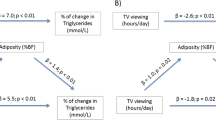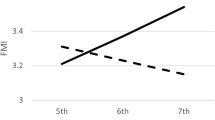Abstract
Objective:
To estimate total energy intake and the energy gap—the daily imbalance between energy intake and expenditure—associated with discretionary behaviors of adolescents, namely their leisure active behaviors (playing or participating in sports and heavy chores), leisure sedentary behaviors (television (TV) viewing and playing video and computer games), productive sedentary behaviors (reading or doing homework).
Design:
Prospective observational study.
Participants:
A total of 538 students (mean age at baseline=11.7 years) from public schools in the Boston area studied prospectively from the fall of 1995 to the spring of 1997.
Measurements:
Anthropometric assessment including height and weight, dietary assessment using a youth food frequency questionnaire and measures of TV, video, reading/doing homework and youth physical activity.
Results:
We estimate the change in total energy intake for each hour change in discretionary activity using regression methods. A 1-h increase in watching TV is associated with a 106 kcal h−1 increase in total energy intake (95% confidence interval (CI): 61–150 kcal day−1). A similar change of 92 kcal h−1 (95% CI: 37–147 kcal day−1) is seen with playing video and computer games. The change in energy intake associated with an hour change in physical activity is 292 kcal h−1 (95% CI: 262–321 kcal day−1). No significant change is associated with reading/doing homework. Assuming that typical energy expenditures are associated with these behaviors, reading/doing homework appears to be an ‘energy neutral’ activity, whereas watching TV and playing video and computer games is associated with an energy surplus. If we assume that physical activity levels are moderate (3.5 METs), then this is also an energy surplus activity. If physical activity is assumed to be vigorous for the entire time allotted (>6.0 METs), an energy deficit could be achieved. We validated these estimates by calculating regressions predicting change in weight. Results indicate that each hour increase in TV viewing is associated with a weight increase of 0.38 kg (95% CI: 0.17–0.59 kg), with no significant associations for the other behaviors. A model with change in BMI as the dependent variable produced similar results.
Conclusion:
Watching TV is an activity associated with a daily energy surplus. Although physical activity is thought of as an energy deficit activity, our estimates do not support this hypothesis. Reading/doing homework is the only discretionary activity examined which appears to be clearly energy neutral. The differential impacts of these discretionary behaviors on energy intake and the energy gap are discussed in relation to food-related advertisements aimed at children and adolescents.
This is a preview of subscription content, access via your institution
Access options
Subscribe to this journal
Receive 12 print issues and online access
$259.00 per year
only $21.58 per issue
Buy this article
- Purchase on Springer Link
- Instant access to full article PDF
Prices may be subject to local taxes which are calculated during checkout

Similar content being viewed by others
References
Ogden CL, Carroll MD, Curtin LR, McDowell MA, Tabak CJ, Flegal KM . Prevalence of overweight and obesity in the United States, 1999–2004. JAMA 2006; 295: 1549–1555.
Kosti RI, Panagiotakos DB . The epidemic of obesity in children and adolescents in the world. Cent Eur J Public Health 2006; 14: 151–159.
Wang Y, Lobstein T . Worldwide trends in childhood overweight and obesity. Int J Pediatr Obes 2006; 1: 11–25.
Wang YC, Gortmaker SL, Sobol AM, Kuntz KM . Estimating the energy gap among US children: a counterfactual approach. Pediatrics 2006; 118: e1721–e1733.
Epstein LH, Wing RR, Koeske R, Valoski A . Effects of diet plus exercise on weight change in parents and children. J Consul Clin Psychol 1984; 52: 429–437.
Ebbeling CB, Feldman HA, Osganian SK, Chomitz VR, Ellenbogen SJ, Ludwig DS . Effects of decreasing sugar-sweetened beverage consumption on body weight in adolescents: A randomized, controlled pilot study. Pediatrics 2006; 117: 673–680.
Ebbeling CB, Leidig MM, Sinclair KB, Hangen JP, Ludwig DS . A reduced-glycemic load diet in the treatment of adolescent obesity. Arch Pediatr Adolesc Med 2003; 157: 773–779.
Robinson TN . Reducing children's television viewing to prevent obesity: A Randomized Controlled Trial. JAMA 1999; 282: 1561–1567.
Prentice A, Jebb S . Energy intake/physical activity interactions in the homeostasis of body weight regulation. Nutr Rev 2004; 62 (7 part 2): S98.
Willet W . Nutritional Epidemiology, 2nd edn. Oxford University Press: New York, 1998.
Dietz Jr WH, Gortmaker SL . Do we fatten our children at the television set? Obesity and television viewing in children and adolescents. Pediatrics 1985; 75: 807.
Allison P . Fixed Effects Regression Methods for Longitudinal Data Using SAS. SAS Institute Inc.: Cary, NC, 2005.
Shadish W, Cook T, Campbell D . Experimental and Quasi-Experimental Designs for Generalized Causal Inference. Houghton Mifflin Company; Boston, MA, 2002.
Wiecha JL, Peterson KE, Ludwig DS, Kim J, Sobol A, Gortmaker SL . When children eat what they watch: impact of television viewing on dietary intake in youth. Arch Pediatr Adolesc Med 2006; 160: 436–442.
Gortmaker SL, Peterson K, Wiecha J, Sobol AM, Dixit S, Fox MK et al. Reducing obesity via a school-based interdisciplinary intervention among youth: planet health. Arch Pediatr Adolesc Med 1999; 153: 409–418.
Rockett HRH, Wolf AM, Colditz GA . Development and reproducibility of a food frequency questionnaire to assess diets of older children and adolescents. J Am Diet Assoc 1995; 95: 336–340.
Field A, Peterson K, Gortmaker S, Cheung L, Rockett H, Fox M et al. Reproducibility and validity of a food frequency questionnaire among fourth to seventh grade inner-city school children: implications of age and day-to-day variation in dietary intake. Public Health Nutr 1999; 2: 293–300.
Rosner B, Willett WC . Interval estimates for correlation coefficients corrected for within-person variation: implications for study design and hypothesis testing. Am J Epidemiol 1988; 127: 377–386.
Ainsworth BE, Haskell WL, Leon AS, Jacobs DR, Montoye HJ, Sallis JF et al. Compendium of physical activities—classification of energy costs of human physical activities. Med Sci Sports Exerc 1993; 25: 71–80.
Harrell J, McMurray R, Baggett C, Pennell M, Pearce P, Bangdiwala S . Energy costs of physical activities in children and adolescents. Med Sci Sports Exerc 2005; 37: 329–336.
Arvidsson D, Slinde F, Larsson S, Hulthen L . Energy cost of physical activities in children: validation of sensewear armband. Med Sci Sports Exerc 2007; 39: 2076–2084.
Troiano R, Berrigan D, Dodd K, Mâsse L, Tilert T, McDowell M . Physical activity in the United States measured by accelerometer. Med Sci Sports Exerc 2008; 40: 181–188.
Cradock A, Wiecha J, Peterson KE, Sobol AM, Colditz GA, Gortmaker SL . Do missing data bias activity estimates? Youth recall and TriTrac accelerometer estimates of physical activity levels. Med Sci Sports Exerc 2004; 36: 525–532.
Fox J . Applied Regression Analysis, Linear Models and Related Methods. CA Sage Publications: Thousand Oaks, 1997.
Epstein LH, Paluch RA, Consalvi A, Riordan K, Scholl T . Effects of manipulating sedentary behavior on physical activity and food intake. J Pediatr 2002; 140: 334–339.
Matheson DM, Killen JD, Wang Y, Varady A, Robinson TN . Children's food consumption during television viewing. Am J Clin Nutr 2004; 79: 1088–1094.
The Role of Media in Childhood Obesity. The Henry J. Kaiser Family Foundation: Menlo Park, 2004; http://www.kff.org/entmedia/upload/The-Role-Of-Media-in-Childhood-Obesity.pdf.
Harrison K, Marske AL . Nutritional content of foods advertised during the television programs children watch most. Am J Public Health 2005; 95: 1568–1574.
Powell LM, Szczypka G, Chaloupka FJ, Braunschweig CL . Nutritional content of television food advertisements seen by children and adolescents in the United States. Pediatrics 2007; 120: 576–583.
Powell LM, Szczypka G, Chaloupka FJ . Exposure to food advertising on television among US children. Arch Pediatr Adolesc Med 2007; 161: 553–560.
Powell LM, Szczypka G, Chaloupka FJ . Adolescent exposure to food advertising on television. Am J Prev Med 2007; 33 (4, Suppl 1): S251.
Buchman DD, Funk JB . Video and computer games in the 90's: Children's time commitment & game preference. Child Today 1996; 24: 12.
Berkey CS, Rockett HRH, Field AE, Gillman MW, Frazier AL, Camargo CA et al. Activity, dietary intake, and weight changes in a longitudinal study of preadolescent and adolescent boys and girls. Pediatrics 2000; 105: e56.
Gordon-Larsen P, Adair LS, Popkin BM . Ethnic differences in physical activity and inactivity patterns and overweight status. Obes Res 2002; 10: 141–149.
Kimm SYS, Glynn NW, Obarzanek E, Kriska AM, Daniels SR, Barton BA et al. Relation between the changes in physical activity and body-mass index during adolescence: a multicentre longitudinal study. Lancet 2005; 366: 301–307.
Campbell K, Waters E, O'Meara S, Kelly S, Summerbell C . Interventions for preventing obesity in children. Cochrane Database Syst Rev 2002;(2): CD001871. Review. Update in Cochrane Database Syst Rev2005;(3): CD001871. PMID: 12076426.
Atlantis E, Barnes EH, Singh MAF . Efficacy of exercise for treating overweight in children and adolescents: a systematic review. Int J Obes 2006; 30: 1027.
Steinbeck KS . The importance of physical activity in the prevention of overweight and obesity in childhood: a review and an opinion. Obes Rev 2001; 2: 117.
Connor SM . Food-related advertising on preschool television: building brand recognition in young viewers. Pediatrics 2006; 118: 1478–1485.
Lobstein T, Dibb S . Evidence of a possible link between obesogenic food advertising and child overweight. Obes Rev 2005; 6: 203–208.
Acknowledgements
This study was supported by grant 57891 from the Robert Wood Johnson Foundation, HD-30780 from the National Institute of Child Health and Human Development, Rockville, MD, and by Cooperative Agreement U48/DP00064-00S1 from the Centers for Disease Control and Prevention. The findings and conclusions in this report are those of the author(s) and do not necessarily represent the official position of the Centers for Disease Control and Prevention nor other funders.
Author information
Authors and Affiliations
Corresponding author
Additional information
Conflict of interest
Kendrin Sonneville has received a training grant from NIDDK in Academic Nutrition. Steven Gortmaker has declared no financial interests.
Rights and permissions
About this article
Cite this article
Sonneville, K., Gortmaker, S. Total energy intake, adolescent discretionary behaviors and the energy gap. Int J Obes 32 (Suppl 6), S19–S27 (2008). https://doi.org/10.1038/ijo.2008.203
Published:
Issue Date:
DOI: https://doi.org/10.1038/ijo.2008.203
Keywords
This article is cited by
-
A multilevel, multicomponent childhood obesity prevention group-randomized controlled trial improves healthier food purchasing and reduces sweet-snack consumption among low-income African-American youth
Nutrition Journal (2018)
-
Cumulative Risk Exposure and Waist Circumference in Preschool-Aged Children: the Mediating Role of Television and Moderating Role of Sex
Annals of Behavioral Medicine (2017)
-
Modern Sedentary Behaviors Favor Energy Consumption in Children and Adolescents
Current Obesity Reports (2013)
-
Mediators of longitudinal associations between television viewing and eating behaviours in adolescents
International Journal of Behavioral Nutrition and Physical Activity (2011)



